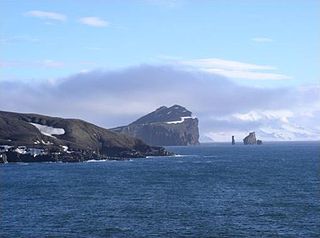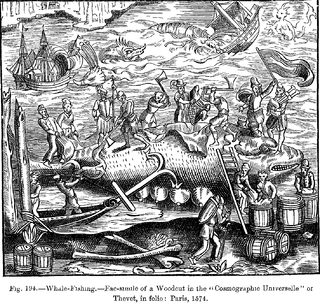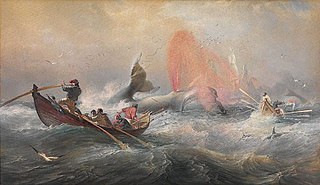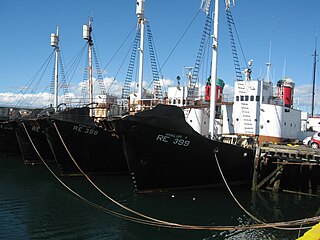Related Research Articles

Whaling is the hunting of whales for their usable products such as meat and blubber, which can be turned into a type of oil that became increasingly important in the Industrial Revolution. It was practiced as an organized industry as early as 875 AD. By the 16th century, it had risen to be the principal industry in the Basque coastal regions of Spain and France. The whaling industry then spread throughout the world and became increasingly profitable in terms of trade and resources. Some regions of the world's oceans, along the animals' migration routes, had a particularly dense whale population, and became the targets for large concentrations of whaling ships, and the industry continued to grow well into the 20th century. The depletion of some whale species to near extinction led to the banning of whaling in many countries by 1969, and to an international cessation of whaling as an industry in the late 1980s.

Deception Island is an island in the South Shetland Islands close to the Antarctic Peninsula with a large and usually "safe" natural harbor, which is occasionally troubled by the underlying active volcano. This island is the caldera of an active volcano, which seriously damaged local scientific stations in 1967 and 1969. The island previously held a whaling station. It is now a tourist destination with over 15,000 visitors per year. Two research stations are operated by Argentina and Spain during the summer season. While various countries have asserted sovereignty, it is still administered under the Antarctic Treaty System.

The southern right whale is a baleen whale, one of three species classified as right whales belonging to the genus Eubalaena. Southern right whales inhabit oceans south of the Equator, between the latitudes of 20° and 60° south. In 2009 the global population was estimated to be approximately 13,600.

Japanese whaling, in terms of active hunting of whales, is estimated by the Japan Whaling Association to have begun around the 12th century. However, Japanese whaling on an industrial scale began around the 1890s when Japan started to participate in the modern whaling industry, at that time an industry in which many countries participated. Japan resumed commercial whaling in July 2019, and since then whaling activities have been confined to its territorial waters and exclusive economic zone.

This article discusses the history of whaling from prehistoric times up to the commencement of the International Whaling Commission (IWC) moratorium on commercial whaling in 1986. Whaling has been an important subsistence and economic activity in multiple regions throughout human history. Commercial whaling dramatically reduced in importance during the 19th century due to the development of alternatives to whale oil for lighting, and the collapse in whale populations. Nevertheless, some nations continue to hunt whales even today.

Lars Christensen was a Norwegian shipowner and whaling magnate. He was also a philanthropist with a keen interest in the exploration of Antarctica.

Corral is a town, commune and sea port in Valdivia Province, Los Ríos Region, Chile. It is located south of Corral Bay. Corral is best known for the forts of Corral Bay, a system of defensive batteries and forts made to protect Valdivia during colonial times. Corral was the headquarters of the system. Economic activities in Corral revolve around forestry, aquaculture, fishing, port services and both heritage and eco tourism.

A whaler or whaling ship is a specialized vessel, designed or adapted for whaling: the catching or processing of whales.

Whaling in Australian waters began in 1791 when five of the 11 ships in the Third Fleet landed their passengers and freight at Sydney Cove and then left Port Jackson to engage in whaling and seal hunting off the coast of Australia and New Zealand. The two main species hunted by such vessels in the early years were right and sperm whales. Humpback, bowhead and other whale species would later be taken.

Whaling in Iceland began with spear-drift hunting as early as the 12th century, and continued in a vestigial form until the late 19th century, when other countries introduced modern commercial practices. Today, Iceland is one of a handful of countries that formally object to an ongoing moratorium established by the International Whaling Commission in 1986, and that still maintain a whaling fleet. One company remains concentrated on hunting fin whales, largely for export to Japan, while the only other one previously hunted minke whales for domestic consumption until 2020, as the meat was popular with tourists. In 2018, Icelandic whalers were accused of slaughtering a blue whale. Whaling was temporarily paused in Iceland between 2019 and 2021 as coronavirus restrictions, competition from subsidized Japanese whaling, and increasing domestic whale watching tourism have hampered the industry, however the practice is set to resume in 2022. A ban may come about by 2024 due to low demand and profitability. Iceland has a whale watching sector, which exists in tension with the whaling industry.
Whaling in Norway involves hunting of minke whales for use as animal and human food in Norway and for export to Japan. Whale hunting has been a part of Norwegian coastal culture for centuries, and commercial operations targeting the minke whale have occurred since the early 20th century. Some still continue the practice in the modern day.

The Nisshin Maru (日新丸) is the primary vessel of the Japanese whaling fleet and is the world's only whaler factory ship. It was the research base ship for the Institute of Cetacean Research for 2002 to 2007. It has a tonnage of 8,145 GT and is the largest member and flagship of the five-ship whaling fleet, headed by leader Shigetoshi Nishiwaki. The ship is based in Japan in Shimonoseki harbor and is owned by Tokyo-based Kyodo Senpaku, which is a subsidiary of the Institute of Cetacean Research.

Anti-whaling refers to actions taken by those who seek to end whaling in various forms, whether locally or globally in the pursuit of marine conservation. Such activism is often a response to specific conflicts with pro-whaling countries and organizations that practice commercial whaling and/or research whaling, as well as with indigenous groups engaged in subsistence whaling. Some anti-whaling factions have received criticism and legal action for extreme methods including violent direct action. The term anti-whaling may also be used to describe beliefs and activities related to these actions.

Jūrō Oka was a Japanese businessman considered the "father of Japanese whaling".
The Basques were among the first people to catch whales commercially, as opposed to aboriginal whaling, and dominated the trade for five centuries, spreading to the far corners of the North Atlantic and even reaching the South Atlantic. The French explorer Samuel de Champlain, when writing about Basque whaling in Terranova, described them as "the cleverest men at this fishing". By the early 17th century, other nations entered the trade in earnest, seeking the Basques as tutors, "for [they] were then the only people who understand whaling", lamented the English explorer Jonas Poole.

Whalers Bay is a small bay entered between Fildes Point and Penfold Point at the east side of Port Foster, Deception Island, in the South Shetland Islands of Antarctica. The bay was so named by the French Antarctic Expedition, 1908–10, under Charcot, because of its use at that time by whalers.
SS Telefon was a Norwegian cargo steamship of about 1,400 GRT built by on the River Tyne in 1900. She was wrecked in South Shetland Islands in 1908, though later salved, repaired and returned to service. She was sunk in a collision off Denmark in 1913 as the British Kinneil.

Isla San Pedro is a private island located off the southeastern shore of Chiloé Island within the commune of Quellón, in Southern Chile.

Commercial whaling in Britain began late in the 16th century and continued after the 1801 formation of the United Kingdom and intermittently until the middle of the 20th century.

A drift whale is a cetacean mammal that has died at sea and floated into shore. This is in contrast to a beached or stranded whale, which reaches land alive and may die there or regain safety in the ocean. Most cetaceans that die, from natural causes or predators, do not wind up on land; most die far offshore and sink deep to become novel ecological zones known as whale falls. Some species that wash ashore are scientifically dolphins, i.e. members of the family Delphinidae, but for ease of use, this article treats them all as "drift whales". For example, one species notorious for mass strandings is the pilot whale, also known as "blackfish", which is taxonomically a dolphin.
References
- 1 2 3 4 5 6 7 8 9 10 11 Quiroz, Daniel (2015). "Balleneros en la niebla: Una mirada para-etnográfica de la caza de ballenas en Chile" [Whalers in the fog: Para-ethnographic outlook of whaling in Chile]. Chungara (in Spanish). 47 (2). doi: 10.4067/S0717-73562015005000025 . Retrieved November 12, 2015.
- 1 2 3 4 Quiroz, Daniel; Carreño, Gastón (2017). "Narrativas etnográficas sobre ballenas y balleneros en las costas de Chile". Antípoda (28). doi: 10.7440/antipoda28.2017.02 .
- 1 2 3 Tonnessen, Johan; Johnsen, Arne (1982). The history of modern whaling. University of California Press. pp. 202–207. ISBN 978-0-520-03973-5.
- 1 2 "The Norwegian who raised the Chilean flag in Antarctica". 28 October 2011. Retrieved 12 January 2013.
- 1 2 Hart, Ian B. (2006). Whaling in the Falkland Islands dependencies 1904-1931: a history of shore and bay-based whaling in the Antarctic. Pequena. p. 12. ISBN 9780955292408.